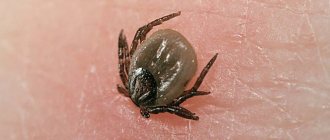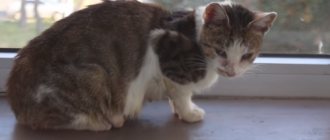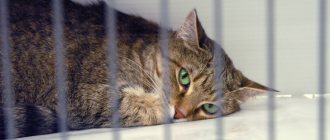Cats are very curious animals, especially small kittens who constantly want to find out something, smell and play with both butterflies and flying insects, including bees. Being a predator by nature, a cat, once outside, especially in the summer, begins to realize its predatory instinct, trying to catch bees crawling on the flowers of plants. If a cat has not previously interacted with bees, then this can end quite sadly for her. With the onset of the warm season, bees in search of nectar are regular visitors to flowering plants, and of course it is not the bee’s fault when a cat or kitten tries to play with it. Cat owners often do not know what to do if their pet is stung by a bee.
Symptoms of a bee sting in a cat . While you are in nature with your cat, where bees are flying in search of nectar, you notice that the cat suddenly begins to behave inappropriately. From a painful bee sting, the cat begins to run, rush, and climb into various places. During an external examination of their pet, the owners note that the cat is breathing heavily, suffocating, the bite site (nose or paw) is swollen, and the bite site is very painful. Increased salivation appears (the cat is drooling), lacrimation, after the bite the cat begins vomiting (the cat is vomiting), convulsions and an increase in body temperature.
With severe bee stings, a cat may develop anaphylactic shock.
Medicines that can be used to relieve symptoms and combat allergies
As mentioned above, the first thing the owner needs to do if a cat shows initial signs of general intoxication and allergies is to take the animal to a veterinary hospital without hesitation. Before a visit to the clinic, medications to eliminate symptoms and alleviate the pet’s condition are allowed to be used only after consultation with a doctor, at least by phone - otherwise the cat can be seriously harmed.
As a rule, veterinarians most often advise in such cases:
- Prednisolone, which inhibits the development of an allergic reaction, is given as an intramuscular injection (dosage - 0.5 ml), or half a tablet.
- Dexamethasone - in the form of an injection of 0.2 ml.
- Benadryl is a fairly universal remedy, suitable even for teenage kittens.
- Diazolin – half a tablet at a time.
- Suprastin is less common, since this drug is less universal and can itself cause an immune response in some cats.
It would not be amiss to emphasize once again that these drugs should not be used independently, without consulting a veterinarian, since if used incorrectly they can suppress the animal’s immunity and lead to the addition of a secondary viral, fungal or bacterial infection.
Those who have repeatedly contacted the veterinarian after a cat was bitten by a wasp know that the clinic can inject the animal with adrenaline, but doing this on your own is prohibited - the risk of further harming the pet is too great.
If a cat is stung by a wasp, and the insect's venom begins to provoke the development of an allergy, one of its symptoms may be an increase in the animal's body temperature. In this case, you should also not lower the temperature with drugs yourself - if its values are critical, only the veterinarian should make a decision on how to relieve this symptom (however, it is quite possible to use a wet, cool towel).
Why do cats bite?
Cats can, of course, become aggressive when they are scared or feel threatened. But many also tend to bite and scratch when petted by their owner. This is called petting-induced aggression, and it has been a topic of discussion among behaviorists for decades. There are three theories why cats do this. First, they are simply letting their owner know that they are no longer happy to be petted. Secondly, they are trying to establish their status. Thirdly, a person who pets them for a while causes negative emotions in cats. It is important for owners to learn more about their cats in order to recognize the telltale signs of aggression caused by petting.
Can a cat be stung by a bee?
| Can a cat be stung by a bee? Is this dangerous for the cat? and what will happen if he bites? P.S. Just no jokes or wit. I really need an answer! |
| Yes. And that’s why cats don’t really catch bees...Christian |
| if one bee bites, nothing will happen. and even if it bites about 30 pieces, it’s not scary, but if they stick around and bite a lot, then the cat may die. Tagir |
| yes) Mister |
| Of course it can, my cat was bitten by a bee right between the eyes, nothing bad happened, I ran around the yard for about 10 minutes not understanding what was happening =) the bite site swelled up, but after a couple of days everything went away, the main thing is to pull out the sting if it remains in the bite siteRicardas |
| Cats no longer catch bees... but a kitten can... it’s dangerous - when it stings in the mouth... the neck swells... and the kitten can die..Alexander |
1. If your cat is bitten in the mouth, nose or throat, contact your veterinarian immediately because swelling may block the airway. 2. If a cat has been bitten by a bee, the stinger may still be in the skin.
If you see one, carefully grasp it with tweezers as close to the skin as possible and remove it. 3
Try to neutralize the bite by washing the affected area with a solution of baking soda (10 g (1 dessert spoon) of soda per 600 ml of water). In case of a wasp sting, the affected area should be washed with a vinegar solution (vinegar half diluted with water). If these measures don't help, try washing the bite area with soap and water to relieve the pain of the bite. 4. Apply a cold compress to the bite site using a piece of cloth soaked in ice water (wrap ice cubes in the cloth if possible) or a bag of frozen peas. These measures will help relieve swelling. If your cat has a normal allergic reaction to a bite. Treatment should be started immediately. Give 10-15 mg of prednisolone intramuscularly once and if the cat does not get better, contact the clinic. (in tablets of 1 mg (0.001 g): 1/2 tablet - 3 times a day on the first day of treatment, 2 times - on the second day of treatment.) We do not recommend that you use lighter (by human standards) allergy medications . Cats are very prone to allergies, Persians especially, which also applies to medications designed to treat allergies. So, suprastin can only worsen the reaction. You may not notice it right away, and time will be lost. It is unlikely, but possible, that prednisone may be rejected. This will become clear immediately - profuse foam at the mouth after taking the drug. In this case, you will have to give up the tablets, the only remaining injections are dexamethasone 0.2 ml once a day. And one more very important note. You should notice the first results of treatment within a few hours. If by the end of the first day of treatment you do not see any improvement, be sure to consult a veterinarian. Treatment with these drugs should not last more than 3 days. Long-term use of prednisolone (dexamethasone) suppresses the immune system, which can lead to the development of other fungal or viral diseases. Family
| As far as I know, just like a person can be allergic to bee venom.Yurik |
| dangerous, did she bite you? and the cat will be scared too One-eyed |
| Maybe And this is dangerous, especially if the cat grabs it with its mouth and the bite falls on the throat. Then the swelling can block the airways and the animal will suffocate. And the allergic reaction can be severe. Estimate how many times a cat is smaller than a person, and the amount of bee venom is the same. If bitten, they give suprastin and consult a veterinarian. Mister |
Questions on the topic:
| How to get powdered sugar at home and in large quantities? (Needed for feeding bees) |
| Is a bee sting - bee shock - life-threatening? |
| Lifespan of a queen bee? |
| What living things other than plants are used by humans to make medicines and treat diseases? |
| What bee diseases should beekeepers watch out for and how to combat them? |
Symptoms
Typically, the consequences of an attack by stinging insects are limited to a local reaction. If the bite did not occur in front of the owner, you can understand that the pet was stung by the following signs:
- hot red localized swelling in a specific location;
- the cat shakes its head or paw;
- profuse drooling;
- restless behavior, attempts to scratch the stung area.
In the event of an allergic reaction to a bite or attack from multiple wasps at once, the following may occur:
- shortness of breath, difficulty breathing;
- tachycardia (fast heartbeat);
- impaired coordination of movements and consciousness;
- state of shock.
Although a wasp or bee can bite a cat even in a city apartment, this situation usually occurs during the summer season, outside the city. The owner must independently help the pet if it is not possible to quickly get to a veterinary clinic.
Disinfestation products
You can treat the wound if a bee has stung a cat with medical alcohol, ammonia, any alcohol tincture, or hydrogen peroxide.
- Tincture of valerian, motherwort, and calendula soothes pain and relieves swelling. A small amount is applied to a cotton swab and applied to the sore spot.
- If there is no alcohol, prepare a paste from soda. Mix kitchen salt and baking soda in equal proportions, dilute with a little water to form a paste. Apply to the skin. Baking soda helps relieve swelling, pain, burning, itching.
- You can disinfect the wound with juice from orange, lemon, onion, and potato. Another effective remedy is laundry soap or an acidic solution. Table vinegar and citric acid are added to the water. They make lotions, apply a compress, wipe the skin.
In the future, to eliminate swelling, decoctions of medicinal herbs are used - chamomile, mint, lemon balm, calendula. The potion is poured with boiling water and left for half an hour. Sore spots need to be treated several times a day. The swelling goes away completely within 3 days.
After a bee stings a cat's nose or other place on its face, an antihistamine should be given to avoid severe allergies. There is no special cat drug. Experts advise:
- Prednisolone. At home, give 0.5 tablets. Turn it into powder, dilute it with water, and pour it into the cat’s mouth. If immediate relief of an allergic reaction is required, an injection is given intramuscularly and 0.5 ml of solution is injected.
- Dexamethasone. More suitable for obvious signs of allergies - vomiting, nausea, difficulty breathing. An injection is given with a solution of 0.2 ml.
- Diazolin. It is recommended if a bee has bitten a kitten, an adult cat, or a cat. Dose – 0.5 tablets at a time. On the first day, an antihistamine is given three times.
- L-cet. A modern antihistamine is produced in the form of a suspension or tablets. In the first case, give 0.5 teaspoon per day, in the second - ¼ of the tablet.
To save a cat’s life after a bee sting, you can give any antihistamine that is in your home medicine cabinet, but then you should show your pet to a specialist. Carry out further therapy under the supervision of a veterinarian.
Photos of cats stung by bees
In the photo you can see how swelling develops in cats bitten by bees.
The muzzle at the site of the lesion swells, the eye closes.
Important! When a bee bites a cat on the nose, it develops swelling not only on the skin, but also in the respiratory tract, which threatens the death of the animal.
Getting a sting in the face or cheek can also lead to serious swelling:
What is first aid?
What to do if a cat is bitten by a bee or wasp? In any case, you will have to provide first aid yourself, and then go to the veterinarian if the need arises.
Help algorithm:
Place the cat in any cool place and give it complete rest. Be sure to bring it from the street into the house if everything happened in the yard. Observe the animal for just a few minutes to rule out symptoms of anaphylactic shock or suffocating edema, when you should rush to the veterinary clinic rather than try to help yourself. If you have the homeopathic medicine “Apis” in your home medicine cabinet, it is recommended to give the cat 5-10 drops orally with a small amount of water. This is especially true in cases where there is a history of insect bites and allergies to them - this should always be the case. Under control of the general condition, you should begin examining the animal’s body to understand where the insect bite occurred. If edema and swelling are found in the area of the larynx, then immediately take your pet to a specialist. Intubation may be necessary, and this can only be done by a specialist.
Remember: wasps do not leave stings, only bees leave stings! If a cat has been bitten by a bee, you need to find a place with a protruding sting and carefully pull it out using tweezers.
It is important not to flatten it, otherwise the intoxication reaction will intensify. If a wasp stings, you can try to lightly squeeze out the ichor with the remaining poison
But this manipulation is only suitable for the first minutes after an insect attack, because then swelling forms and the hole narrows so much that nothing can be squeezed out. During any manipulations at the site of swelling, the cat must be well secured - this is very painful!
After removing the sting and squeezing out any remaining toxins, the bite site can be treated with the following solutions and substances:
- fruit acids (rub with a piece of lemon, apple, orange, you can add a pulp of the pulp of these fruits);
- vinegar water (9% table or natural apple cider vinegar is mixed with water in a 1:1 ratio, a cotton swab is generously moistened and applied to the bite site. The exception is bites in the mouth or near the mouth);
- citric acid solution (make slightly acidic water, moisten a cotton swab, apply to the bite site);
- a soap solution made from laundry soap relieves itching (soap a cotton swab generously and periodically wash the wound);
- soda solution (dilute a third of a level teaspoon in 100 ml of water, wipe with a cotton swab dipped in the solution);
- ammonia (do not generously lubricate the bite site if it is not on the head - legs, stomach, back...);
- turmeric (sprinkle generously on the bite area, after moistening it with plain water).
Applying cold to the bite site
Take something cold (ice, some kind of product) out of the freezer, wrap it in a thin cotton towel or napkin and apply it for 10 seconds with the same breaks. Cold will sharply narrow the skin capillaries, preventing the spread of poison and increasing swelling. Cold can be applied before treating the bite site with topical solutions, especially if the animal has been injured by a wasp. Then cold is first applied, then local treatment is done.
Recognizing the signs of a bite
In most cases, cats exhibit a localized reaction where the bite area becomes slightly swollen and tender. Often, a bee or wasp can sting in the face, usually in the nose area, or in the paw. Check to see if the sting remains on the skin. When a bee stings, it leaves a sting with spikes in the body of the victim. Wasps do not lose their stings, so they can sting a victim several times in a row, which increases the degree of threat to your pet.
Severe swelling, redness and pain are the first signs of an acute reaction. The animal may show that it is in pain, for example, it will begin to limp or hobble, meow loudly, or vigorously lick the bite site. The following symptoms are observed in anaphylactic shock:
- Rash.
- Disorientation or stumbling.
- Vomiting or diarrhea.
- Pale gums.
- Low body temperature and cold extremities.
- Fast or slow heart rate.
According to the North Asheville Veterinary Clinic, other signs to watch for include fainting, shallow or rapid breathing, increased salivation, changes in behavior, mood, and thinking abilities. If any of these signs occur, take your pet to a veterinarian immediately.
First aid
What to do if a cat is bitten by a bee, there is a certain mechanism of action. The insect leaves a sting in the pet's body, which continues to release poison; it must be removed. If, upon careful examination of the affected area, no bee sting is found, it means that the cat was bitten by a wasp.
The sting should be removed carefully using tweezers. Nails can damage the structure and leave part of an organ in the body, which is highly undesirable.
Surgery will be required to remove it. Next, you should treat the sore spot with any antiseptic to neutralize the effect of the poison. For these purposes, medications and folk remedies are used. After disinfection, you need to relieve swelling and reduce pain. In this case, use a cold compress or ice cubes wrapped in a towel. The swelling will finally go away in a few days. It is recommended to repeat the procedure several times a day.
If there are signs of a severe allergic reaction, before being examined by a specialist, it is allowed to give the cat an antihistamine or activated charcoal to remove toxins.
Cat treatment
The bite goes away completely within a week. Pain and swelling gradually change. There is a risk of secondary infection if the pet begins to scratch the itchy wounds. To avoid suppuration and the development of ulcers, wounds after a bite should be treated daily to reduce itching.
It is allowed to use topical creams and ointments: Zvezdochka balm, Fenistil Gel, Beinval. Or use folk remedies:
- juice of fresh parsley leaves;
- leaf of plantain, yarrow;
- dandelion roots;
- lemon slice;
- a piece of raw potato;
- tansy decoction;
- aloe juice;
- chopped onion, garlic;
- salty water.
Medicines are applied to the skin, lotions and compresses are made. If the situation does not improve within 3 days, you should seek help from a specialist. In most cases, to alleviate the suffering of a pet, it is enough to provide first aid and monitor the cat’s well-being for several days.
The cat was bitten by a wasp. In the summer, such incidents are not uncommon, especially if the owners take their pet out of town. Cats and dogs are very playful animals who enjoy chasing butterflies and flies. However, not all insects are harmless.
The result of a fun game can be a very painful bite, and often four-legged pets can stir up a hornet's nest. Retribution for such a prank will not be long in coming.
Prevention
Prevention of bee stings can only be done by protecting your home - mosquito nets on windows, nets on doors. Animal bowls should not be placed outside.
And, of course, pets must be closely monitored and treated with repellents.
Most often, a bee sting does not pose a danger to a cat; the symptoms go away within a few days, but the location of the poison causes great suffering to the pet. If the animal has been bitten by bees before and has not had any allergic reactions, then the cat will tolerate another bite well.
A big purring hello to everyone!
Summer, oh summer!!! Summer drives me crazy! There are all sorts of insects flying around, buzzing in your ear, and you really want to catch them and taste them.
It's a pity that they still have wings (((
Did you know that cats can have an allergic reaction to insect bites? A?
Do you know what to do if
your
cat bitten
, for example,
by a bee
?
Find out about it soon!
Sorry that I immediately scared you with allergies, but what to do? We need to fully understand the issue of bites.
For most cats, bites from ants, bees, hornets, wasps and spiders cause only an external reaction, i.e. swelling or blister.
But on some cats, such bites can make such an “indelible impression” that they can fall into a state of shock and begin to behave quite strangely: rushing around the house, yelling or hissing. Wait a couple of minutes: if the cat does not calm down, you should immediately consult a doctor, especially if, in addition to excitement, any of the following symptoms appear:
Prostration;
Excessive salivation;
Pupil dilation;
Rapid pulse.
If you wait a long time for the doctor, then you yourself will need to provide first aid to your tailed and mustachioed pet (pet). Give your cat a tablet of Tavegil, Suprastin, or another anti-allergic drug.
If the cat has become lethargic, then pour lukewarm strong black tea into his or her mouth (as much as possible) and go to the doctor.
If a cat is bitten by a bee
, wasp, or bumblebee, then first you will need to remove the remaining sting from the wound. To do this, use tweezers, a thin knife, or a scalpel pre-treated with an alcohol-containing liquid.
Take your time, be careful!
Then treat the affected area with hydrogen peroxide (if you don’t have it on the farm, use highly diluted vinegar).
An excellent anti-inflammatory effect is achieved by applying Gamabiol ointment.
A bag with several pieces of ice (frozen meat/vegetables) tied to the wound, or a “compress” made from a tea bag soaked in warm water, can also help relieve itching on the skin from a bite.
Yes, and don’t forget about the anti-allergen tablet again.
And now you will be very surprised, my dear friends, when you find out that a mosquito bite can sometimes cause the formation of ulcers on a cat’s skin.
It turns out that mosquito saliva is full of allergens (who would have thought that these little vampires even have saliva). Mosquitoes love to bite cats on their cute faces, ears, between their toes and pads. So, do not leave cats outside among mosquitoes for long periods of time.
If the kitty was at the dacha for the first time or was on a walk for the first time, then be sure to examine her after that for the presence of swelling and blisters.
As I already said, in particularly sensitive cats, mosquito bites can cause ulcers on the skin.
An injection with a drug such as dexafort in a dosage of 0.2 ml helps quite quickly against this.
Now you know everything about what to do if
Your
cat was bitten by a bee
or some other harmful insect.
I wish you, your family, your beloved cats and cats only the right bees, and that there are as few blood-sucking insects in your life as possible!
Your black happy cat Jose Carreras, with love at la-murmur.ru.
PS: The article is the property of the site site
When copying any materials, AN ACTIVE LINK TO THE SITE IS REQUIRED!
If a cat is stung by a bee, it is necessary to provide first aid and then act according to the circumstances. If your pet's health worsens, you should show it to a veterinarian. The most dangerous bites are on the muzzle, neck, and nose. If a severe allergic reaction develops, the animal risks dying.
Are bee or wasp stings harmful to cats?
In most cases, a bee or wasp sting is not life-threatening to your cat. However, they can be very irritating and distressing to your pet, and if stung in certain areas or multiple times, it can lead to more severe symptoms.
Cats that are stung and develop severe swelling in the mouth and neck may have a narrowing of the airways. If your cat has been stung by a bee or wasp and is struggling to breathe, then this is an emergency and you should contact your veterinarian immediately.
Bites to the paws can cause pain when walking and may cause your cat to limp. It may take a few days for the lameness to go away as the swelling subsides.
When to go to the vet
In the following situations, you need to immediately take the animal to a veterinarian:
- a wasp/bee bit a small kitten;
- the bite was in the head area, and especially somewhere in the neck;
- a severe allergic reaction with angioedema and difficulty breathing is visible;
- the organ of vision was damaged (bite directly in the eye);
- Some time after the bite, the cat loses its appetite, apathy appears, the temperature of the whole body rises, and the place where the insect stung swells or begins to fester.
What the veterinarian urgently introduces:
- prednisolone: 0.5-1 ml subcutaneously/intramuscularly;
- dexamethasone: 0.2-1 ml subcutaneously/into the muscle;
- Benadryl (diphenhydramine, diphenhydramine): 0.5-1 ml intramuscularly;
- Diazolin: ½ tablet orally. or pills, but only in cases where there is no swelling of the pharynx and swallowing is not difficult;
- aminophylline: 0.1-0.5 ml into the muscle or subcutaneously to improve ventilation in case of swelling of the airways.
- adrenaline 0.1% - administered in particularly urgent cases of anaphylaxis. The dosage is determined only by a veterinarian in each individual case, because If the calculation is incorrect, you can get the opposite effect.
In most cases, the cat’s body copes with wasp and bee stings on its own - swelling, swelling, pain, lameness subside and disappear within 2-7 days (up to a maximum of 10 with increased individual sensitivity of the body). Cases when urgent veterinary care is required are quite rare, but every cat owner should be able to figure out when it is really needed.
Many owners (especially those who like to take their furry pet to the country) sooner or later face the question: what to do if a cat is bitten by a wasp? In most cases, no special procedures are required: if the bite occurs on the paw or body, the pain and itching after it will go away quite quickly on their own - the owners may not even realize what happened.
Even when a cat has been bitten by a wasp, and as a result the animal has a large blister on its paw, making it difficult to step on it, everything can be left as it is - the pain will go away on its own within a few days, and the animal will return to normal life.
However, there are a number of cases when the owner definitely needs to show more attention to the condition of the pet in case of such bites. This includes the following situations:
- If the bite occurs on the animal's head, face, mouth, nose or throat. In this situation, swelling can spread to the respiratory tract and lead to suffocation of the animal.
- If a wasp has bitten a cat on the eye. Such bites are fraught with severe inflammation, suppuration and other serious complications.
- A wasp bit a little kitten. Several portions of the venom of this insect can lead to serious intoxication of the baby and even his death.
- If your cat is highly sensitive to insect poisons.
In such situations, the first thing the pet owner should do is take it to the veterinarian. However, sometimes complications after wasp bites can appear very quickly, so the owner needs to have time to take measures to preserve the health of the cat before visiting a specialist.
Signs of anaphylactic shock
- weakness, unnatural behavior: the animal is lethargic or overly excited;
- vomit;
- mucous membranes are pale or bluish;
- breathing is difficult, wheezing is heard;
- the pulse quickens and becomes weak;
- cramps, involuntary urination.
Anaphylactic shock occurs in one animal in a thousand, but it can cause death. If a cat shows signs of anaphylactic shock after an insect bite, it is necessary to take the animal to the veterinarian as soon as possible. A cat can die within an hour if you don't give it help.
First aid
Every owner must know what to do if a cat is bitten by a bee. First of all, you need to provide first aid to the animal before taking the pet to the veterinarian.
- When a bee stings, it leaves a sting in the wound. First aid is to remove the sting. The tiny bee sting is almost impossible to reach with your hands; you need to use tweezers and carefully remove it without crushing it. Before you begin to remove the sting from the wound, the cat needs to be well secured - any manipulation at the site of the bite will be very painful.
- After the sting is removed, the bite site should be washed with soap and treated with a solution of vinegar (1:1 with water) or chlorhexidine.
- Apply cold to the bite site - ice or any frozen product, be sure to first wrap it in cloth.
Treatment of the bite site
The bite site can be treated with hydrogen peroxide, but the most effective way is to rinse with a vinegar solution.
Soap will also help relieve some of the pain at the site of the bite; you should wash the wound regularly with a soapy solution.
If the bite occurs in the eye area, under no circumstances should you wash it with vinegar or peroxide. A chamomile solution is used to wash the eyes.
A cold compress will help reduce the effects of the bite and lower the animal's body temperature, because During the spread of bee venom, body temperature rises.
Treatment with drugs
A bee sting is always painful and can lead to serious complications. If bitten in the paw area, the animal will not be able to move normally for several days. And bites to the head, larynx, mouth, eyes or genitals can be fatal for your pet.
To treat bites on the paws or body of an animal, local treatment is sufficient; no medical intervention is required. If a bee stings in the head or genital area, it is imperative to carry out medical treatment and strictly under the guidance of a veterinarian. Any medications and dosage must be prescribed by a doctor, even if it is impossible to deliver the animal to the clinic (consultations by telephone).
Treatment consists of stopping the spread of poison and absorption into the blood. Be sure to administer prednisolone to reduce the manifestation of allergic reactions. Prednisolone can be given as tablets or intramuscularly. Injections are more effective, the medicine begins to act much faster than tablets, and it is not always possible to give the cat a tablet. The dosage of the drug must be calculated by a veterinarian, but if it is impossible to obtain advice, the dose of the drug is 0.1 ml per 1 kg of animal. Prednisolone can be administered every 12 hours.
Instead of prednisolone, you can give dexamethasone at a dosage of 0.2 ml per 1 kg of animal weight. It is not advisable to give Suprastin to animals, because often causes adverse reactions in cats.
Contacting a veterinarian
If a cat shows signs of an allergic reaction, the animal must be taken to a veterinarian - in this case, minutes can count. If a severe allergy occurs - for example, swelling of the larynx, respiratory arrest, only a doctor can restore breathing by installing an oxygen tube.
In addition, in case of swelling or shock, it is necessary to inject adrenaline - including intravenous drips. Adrenaline should be administered carefully and slowly; only a qualified veterinarian can calculate the dosage and frequency of administration.
But even if the animal does not experience an acute reaction, and the bite occurs in the area of the head, mouth, eyes or genitals, it is necessary to show the pet to a veterinarian. Swelling of the larynx or mouth can, if left unchecked, severely impair respiratory function. A bite to the eye area can lead to blindness or inflammation. And swelling in the genital area can slow down or completely stop urination - in this case, a catheter must be installed.
It is imperative to take kittens to the doctor, especially blind ones; small kittens have weak immunity and the dosage of poison significantly exceeds the dose of an adult animal.
Some breeds of cats are more prone to allergic reactions - for example, Angora, Persian, British cats - these animals must be shown to a doctor, because the allergic reaction may be delayed.
Allergy
Swelling from a bee sting is already a sign of a serious problem. If this is all you need to do, you can cope without specialized help. But when a tumor of the larynx, vomiting or diarrhea, and heart rhythm disturbances are added to this, it is worth talking about an allergic reaction. It is no longer possible to do without the use of antihistamines.
At home, homeopathic remedies such as Apis tablets will help prevent the development of a reaction when a cat is stung by a bee. You can also give Tavegil, Suprastin, Diazolin or Diphenhydramine.
If a bee gets stung in the face or enters the oral cavity, it is recommended to use the following remedies:
- a Prednisolone tablet is crushed into powder, diluted with water and poured into the cat’s mouth; if this option does not help, take the drug in an ampoule and inject the medicine;
- if you have nausea, vomiting, or difficulty breathing, you will need a Dexamethanose injection;
- If you are allergic to bee stings, L-cet suspension helps.
If these medications do not provide relief and the allergic reaction continues to worsen, medical attention will be needed.
L-cet











